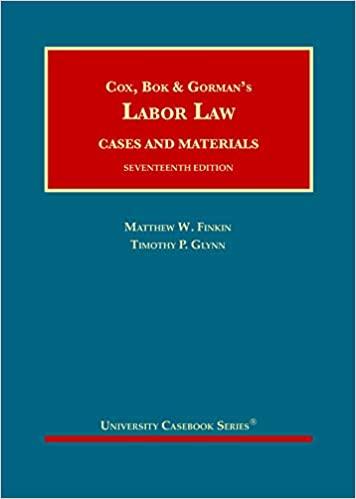Question
The police department in the city has about 1000 officers. The demographic make-up of the department has historically been white male. Currently, the department is
The police department in the city has about 1000 officers. The demographic make-up of the department has historically been white male. Currently, the department is about 70% white officers, 15% black officers, 12% Hispanic officers, and 3% other ethnicities. The gender make-up of the department is about 75% male and 25% female. The police chief is a white male officer who has only worked for this department, rising through the ranks, with 20 years of service. The four deputy Chiefs are two white males, one black male, and one white female. The seven city precincts are commanded by four white males, two black males, and one black female officer. The city is currently working under Federal Consent Decrees due to allegations of racial issues within the police department.
The department has a small community policing unit. This unit does not go out into the community and work with neighbors. It is mainly a crime analysis unit. Most of the people in this unit are civilian employees who are overseen by officers. The officers take the information to the precinct commanders. The precinct commanders can then use that information in the community.
Officers work in sectors and have partners. Officers generally work in the same sector on each shift. Each precinct is broken down into five sectors. The neighborhood in this scenario is in Precinct 2. Since the 1960s, the second precinct has been an area with the most public housing, the most rental housing, and the least homeownership in the city. Before that, the area was where newly arrived immigrants would normally reside until they could move out into other areas of the city or suburbs. Since the 1960s, the area has been primarily African American.
Precinct 2 has had a history of troubles with community members. There are more allegations of misconduct by police in this precinct than any other precinct. The current elected city administration and police leaders try to get more black officers to work in this precinct. Part of the Consent Decree is to form partnerships with community members in Precinct 2. While this has been tried, in the opinion of the community none have succeeded to date. The community feels that the police department just tries to placate them, while systemic changes are never actually implemented. Currently, the precinct has a black male commander. This is a recent change. The last commander was removed after an officer-involved shooting occurred, and the community felt there was no accountability in the incident. In an effort to work with different organizations within the precinct, the Chief put the department's first black commander in charge of the precinct.
The new precinct commander started inviting the community to meet with him. He formed partnerships and began a weekly group that meets to discuss what's going on within the community. This group discusses issues about the police department and issues that the department can assist in solving. The new commander is implementing forms of community policing within the precinct. Each officer must come up with a way to spend 4 hours per month doing something with or for the community.
The police department utilizes a CompStat form of police management. The Chief meets weekly with the precinct commanders to discuss crimes that have occurred. The precinct commander must address if those crimes are rising, and what they are doing to reduce those crimes. Precinct commanders are held responsible for reducing crime within their precincts. They are expected to develop ways to reduce crime and keep the community pleased with the services provided.
Precinct 2 has traditionally had little interaction with the community. Each new commander would attempt to form stakeholder groups; however, there was never a true feeling of trust or commitment from the community or the department. The new commander sets standards that will hold his officers accountable regarding issues that are being raised by these stakeholder groups. Whether trust will be established depends on whether the commander can successfully implement changes and if the community sees those changes.
- What do law enforcement officers need to know about the causes of crime to manage individuals who are committing criminal behavior?
- How can the understanding of theories support law enforcement policy in the field and help prevent crime?
- How do these theories relate to the police using or understanding criminology to prevent or reduce crime?
- What can law enforcement do besides engaging or arresting for criminal behaviors?
Step by Step Solution
There are 3 Steps involved in it
Step: 1

Get Instant Access to Expert-Tailored Solutions
See step-by-step solutions with expert insights and AI powered tools for academic success
Step: 2

Step: 3

Ace Your Homework with AI
Get the answers you need in no time with our AI-driven, step-by-step assistance
Get Started


